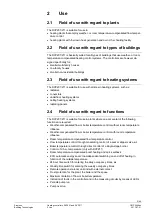
20/46
Siemens
Heating controllers RVP201 and RVP211
CE1P2464en
Building Technologies
3 Technical design
2017-07-21
This type of control provides PI control during the control process, the I-part ensures
that the required room temperature will be reached and maintained with no offset. .
This type of control is used primarily in plants or buildings where a room is suited as a
reference room for the room temperature.
Prerequisites for this type of control:
Outside sensor connected
Room unit connected
Room authority set in the range 0…100 %
The compensating variables used for weather-compensated control with room influence
are:
The composite outside temperature
The setpoint / actual value deviation of the room temperature
The setpoint of the flow temperature is continuously shifted in function of the composite
outside temperature (via the heating curve). Also, any room temperature deviation pro-
duces an instant parallel displacement of the heating curve. The correlation between
the extent of the temperature deviation and the degree of displacement is defined by
the room authority, which is dependent on
the selected authority
the setpoint / actual value deviation of the room temperature
the selected heating curve slope
These three factors are used to generate the corrective variable for the flow tempera-
ture setpoint.
This type of control is used primarily in well insulated buildings or buildings with consid-
erable heat gains where
several rooms are occupied at the same time
a room is suited as a reference room for the room temperature
3.3.7 Control
process
If the flow temperature deviates from the setpoint, a two-port seat valve or mixing valve
(three-port seat or slipper valve) driven by an electric actuator is controlled in a step-
wise fashion until the setpoint is reached.
The RVP201/211 is suited to drive electric or electro-hydraulic actuators with a running
time of 2 to 3 minutes, whereby a maximum running time of 6 minutes may not be ex-
ceeded.
If the flow temperature deviates from the setpoint, a two- or three-port seat valve driven
by an electro-thermal actuator is controlled in on / off mode until the setpoint is
reached. The switching differential is constant at 1 K (fixed value).
The RVP201/211 is suited to drive electro-thermal actuators with a running time of 8 to
16 minutes.
Two-position control maintains the required boiler temperature by switching the burner
on and off. The control commands to the burner are delivered via the output relay.
The minimum running time of the burner is 4 minutes (fixed value). The switching dif-
ferential is adjustable in the range 1…20 K.
The controller compares the actual value of the boiler temperature with the setpoint. If
the boiler temperature falls below the setpoint by an amount equal to half the switching
differential, the burner is switched on. If the boiler temperature exceeds the setpoint by
half the switching differential, the burner is switched off again.
If there is no more deviation before the minimum burner running time has elapsed, the
burner will still remain switched on until that time has elapsed (burner cycling protection.
Weather-compensated
control with room
influence
Three-position flow
temperature control
Two-position flow tem-
perature control
Two-position boiler
temperature control
















































